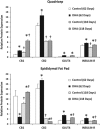Dietary DHA reduces downstream endocannabinoid and inflammatory gene expression and epididymal fat mass while improving aspects of glucose use in muscle in C57BL/6J mice
- PMID: 26219414
- PMCID: PMC4722239
- DOI: 10.1038/ijo.2015.135
Dietary DHA reduces downstream endocannabinoid and inflammatory gene expression and epididymal fat mass while improving aspects of glucose use in muscle in C57BL/6J mice
Abstract
Objectives: Endocannabinoid system (ECS) overactivation is associated with increased adiposity and likely contributes to type 2 diabetes risk. Elevated tissue cannabinoid receptor 1 (CB1) and circulating endocannabinoids (ECs) derived from the n-6 polyunsaturated acid (PUFA) arachidonic acid (AA) occur in obese and diabetic patients. Here we investigate whether the n-3 PUFA docosahexaenoic acid (DHA) in the diet can reduce ECS overactivation (that is, action of ligands, receptors and enzymes of EC synthesis and degradation) to influence glycemic control. This study targets the ECS tonal regulation of circulating glucose uptake by skeletal muscle as its primary end point.
Design: Male C57BL/6J mice were fed a semipurified diet containing DHA or the control lipid. Serum, skeletal muscle, epididymal fat pads and liver were collected after 62 and 118 days of feeding. Metabolites, genes and gene products associated with the ECS, glucose uptake and metabolism and inflammatory status were measured.
Results: Dietary DHA enrichment reduced epididymal fat pad mass and increased ECS-related genes, whereas it reduced downstream ECS activation markers, indicating that ECS activation was diminished. The mRNA of glucose-related genes and proteins elevated in mice fed the DHA diet with increases in DHA-derived and reductions in AA-derived EC and EC-like compounds. In addition, DHA feeding reduced plasma levels of various inflammatory cytokines, 5-lipoxygenase-dependent inflammatory mediators and the vasoconstrictive 20-HETE.
Conclusions: This study provides evidence that DHA feeding altered ECS gene expression to reduce CB1 activation and reduce fat accretion. Furthermore, the DHA diet led to higher expression of genes associated with glucose use by muscle in mice, and reduced those associated with systemic inflammatory status.
Figures


Similar articles
-
Metabolic effects of n-3 PUFA as phospholipids are superior to triglycerides in mice fed a high-fat diet: possible role of endocannabinoids.PLoS One. 2012;7(6):e38834. doi: 10.1371/journal.pone.0038834. Epub 2012 Jun 11. PLoS One. 2012. PMID: 22701720 Free PMC article.
-
Hind limb suspension and long-chain omega-3 PUFA increase mRNA endocannabinoid system levels in skeletal muscle.J Nutr Biochem. 2012 Aug;23(8):986-93. doi: 10.1016/j.jnutbio.2011.05.005. Epub 2011 Nov 3. J Nutr Biochem. 2012. PMID: 22051448
-
Endocannabinoid dysregulation in the pancreas and adipose tissue of mice fed with a high-fat diet.Obesity (Silver Spring). 2008 Mar;16(3):553-65. doi: 10.1038/oby.2007.106. Epub 2008 Jan 17. Obesity (Silver Spring). 2008. PMID: 18239598
-
Endocannabinoid signaling and energy metabolism: a target for dietary intervention.Nutrition. 2011 Jun;27(6):624-32. doi: 10.1016/j.nut.2010.11.003. Epub 2011 Apr 6. Nutrition. 2011. PMID: 21470818 Review.
-
Dietary PUFAs and Exercise Dynamic Actions on Endocannabinoids in Brain: Consequences for Neural Plasticity and Neuroinflammation.Adv Nutr. 2022 Oct 2;13(5):1989-2001. doi: 10.1093/advances/nmac064. Adv Nutr. 2022. PMID: 35675221 Free PMC article. Review.
Cited by
-
Fatty Acid-Derived N-acylethanolamines Dietary Supplementation Attenuates Neuroinflammation and Cognitive Impairment in LPS Murine Model.Nutrients. 2022 Sep 19;14(18):3879. doi: 10.3390/nu14183879. Nutrients. 2022. PMID: 36145255 Free PMC article.
-
Emerging class of omega-3 fatty acid endocannabinoids & their derivatives.Prostaglandins Other Lipid Mediat. 2019 Aug;143:106337. doi: 10.1016/j.prostaglandins.2019.106337. Epub 2019 May 11. Prostaglandins Other Lipid Mediat. 2019. PMID: 31085370 Free PMC article. Review.
-
Dietary linoleic acid lowering alone does not lower arachidonic acid or endocannabinoids among women with overweight and obesity: A randomized, controlled trial.Lipids. 2023 Nov;58(6):271-284. doi: 10.1002/lipd.12382. Lipids. 2023. PMID: 38100748 Free PMC article. Clinical Trial.
-
Association between plasma endocannabinoids and appetite in hemodialysis patients: A pilot study.Nutr Res. 2016 Jul;36(7):658-62. doi: 10.1016/j.nutres.2016.03.009. Epub 2016 Apr 1. Nutr Res. 2016. PMID: 27333956 Free PMC article.
-
Maternal dietary DHA and EPA supplementation ameliorates adverse cardiac outcomes in THC-exposed rat offspring.Sci Rep. 2025 Mar 10;15(1):8316. doi: 10.1038/s41598-025-92844-6. Sci Rep. 2025. PMID: 40064971 Free PMC article.
References
-
- 1De Petrocellis L, Melck D, Bisogno T, Milone A, Di Marzo V. Finding of the endocannabinoid signalling system in Hydra, a very primitive organism: possible role in the feeding response. Neuroscience 1999; 92: 377–387. - PubMed
-
- 3Piazza PV, Lafontan M, Girard J. Integrated physiology and pathophysiology of CB1-mediated effects of the endocannabinoid system. Diabetes Metab 2007; 33: 97–107. - PubMed
-
- 4Howlett AC. Cannabinoid receptor signaling. Handb Exp Pharmacol 2005; 168: 53–79. - PubMed
-
- 5Howlett AC. Cannabinoid inhibition of adenylate cyclase. Biochemistry of the response in neuroblastoma cell membranes. Mol Pharmacol 1985; 27: 429–436. - PubMed
Publication types
MeSH terms
Substances
Grants and funding
LinkOut - more resources
Full Text Sources
Other Literature Sources
Medical

